If we could all attract more northern flickers to our yards we might be able to help boost their population, which has been on the decline since the 1960s. Since they live nearly everywhere throughout North America we all have a good opportunity to pitch in. Besides, wouldn’t it be a thrill to host one at your feeder?
No need to waste time online trying to learn more about them and how to attract them to your yards – I’ve already done the work for you.
I dove into my wild bird books and tapped into the extensive experience of my fellow backyard birders and present to you 5 simple ways to attract northern flickers to your yard.
- Offer food they prefer
- Avoid clearing dead, dying, or fallen trees
- Plant fruit-bearing trees & shrubs
- Have water available
- Hang a nesting box
Before I get into the detail I’d first like to share where they live, what they look like, their habitat, sounds, diet, mating, and nesting habits.
If you’re in a hurry feel free to skip ahead to the details.
Where Northern Flickers Live
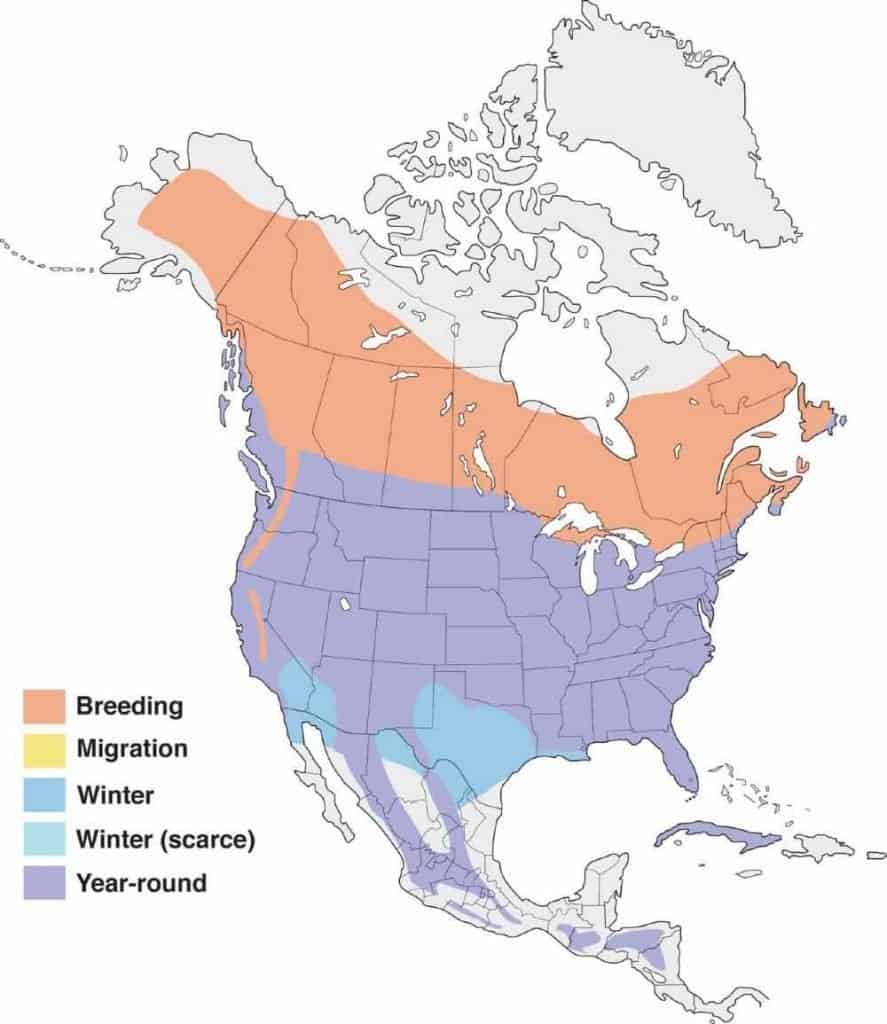
As mentioned, this bird can be found throughout most of North America. As the map indicates, they are a mix of year-round and migrating birds.
- Breeding birds in the north will migrate south in the fall starting late September – October.
- In spring they’ll migrate north around late March – April.
Northern Flickers – Unique Woodpeckers
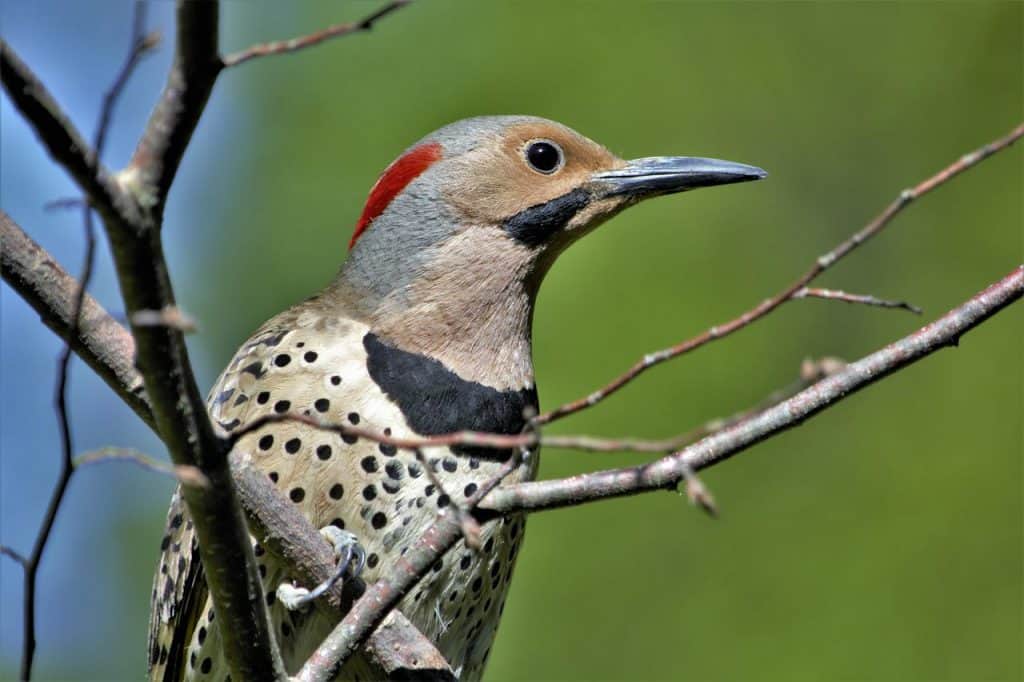
Although this bird is a member of the woodpecker family, they seem to have more differences than similarities with its relatives. Here are a few:
- Most woodpeckers’ names end with “woodpecker” while this is noticeably missing from the northern flicker.
- Most woodpeckers drill into trees to get at the insects they so love to eat while northern flickers primarily forage for insects on the ground.
- Most woodpeckers are year-round birds while northern flickers are a mix of migrating and year-round birds.
- Most woodpeckers’ base color is black while the northern flickers are brown.
- Most woodpeckers have a single appearance for male vs female while northern flickers have three different variations going on – the yellow-shafted, red-shafted, and intergrade.
The yellow-shafted northern flicker is found in the eastern and northern parts of the range;
The red-shafted northern flicker is found in the western part of the range;
The intergrade northern flicker, which is a result of the yellow-shafted and red-shafted birds interbreeding, is found where the yellow-shafted and red-shaft birds’ ranges overlap throughout the Great Plains (Colorado, Iowa, Kansas, Minnesota, Montana, Nebraska, New Mexico, North Dakota, Oklahoma, South Dakota, Texas, and Wyoming.)
Although this bird is a member of the woodpecker family, they seem to have more differences than similarities with its relatives.
As for similarities, all I could uncover was the infamous long, wedge-shaped beak and super-long barbed tongue.
Appearance
The northern flicker is a large bird about 12.5″ long. As mentioned earlier, there are 3 types each with its own nuance of colors.
While ALL northern flickers have brown backs with black bars, black crescent on the upper chest, and white with black spots on the belly and underparts, the three types each have their own nuance of colors.
Yellow-Shafted Northern Flicker
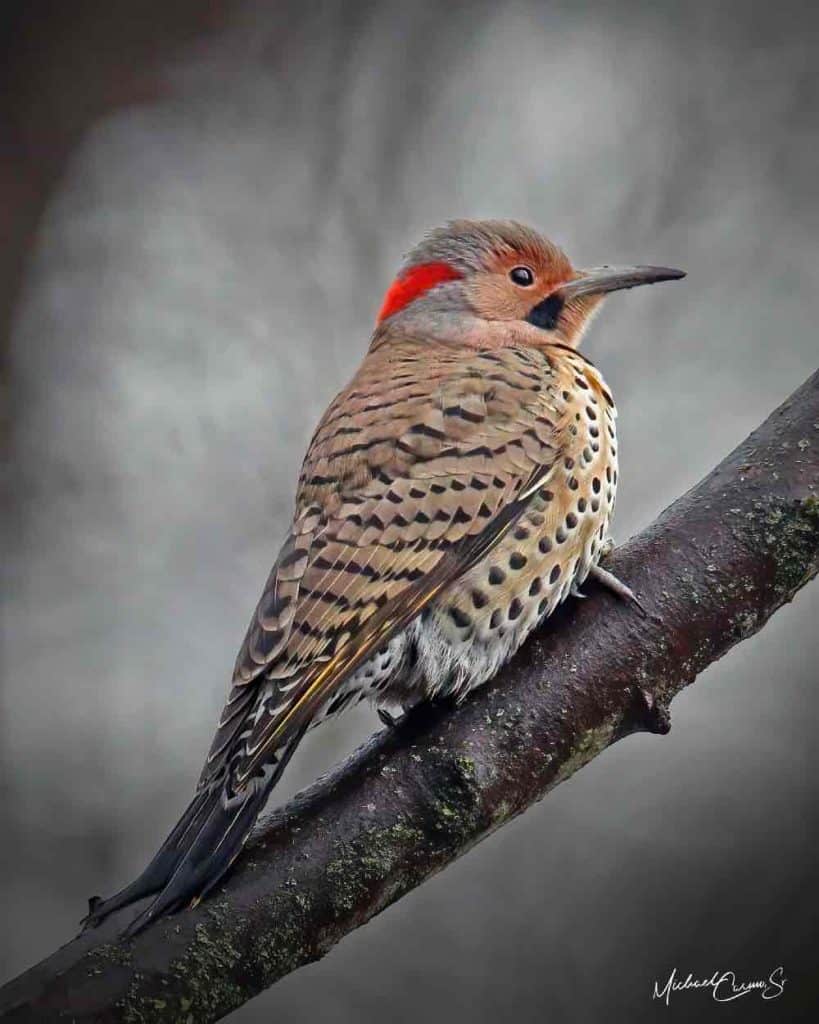
The yellow-shafted northern flicker has bright yellow underwings and undertail. It has a gray crown, a tan face, and a red patch on the nape. The male has a black swipe on his cheek, the female does not.
Red-Shafted Northern Flicker
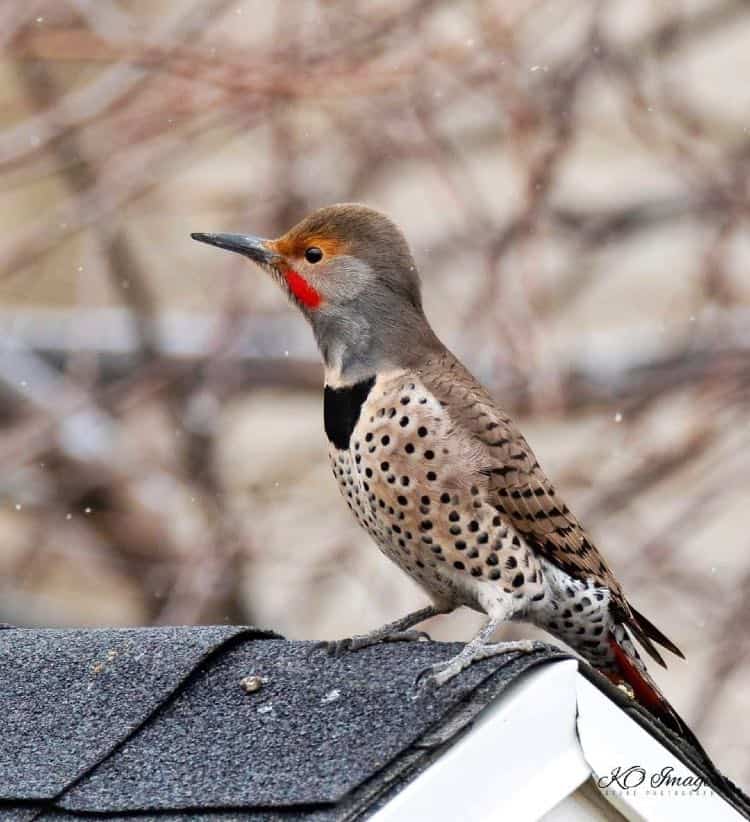
The red-shafted northern flicker has pink underwings and undertail, brown crown, gray face, and crown & nape are brown. The male has a red swipe on his cheek, the female does not.
Northern Flicker Intergrade
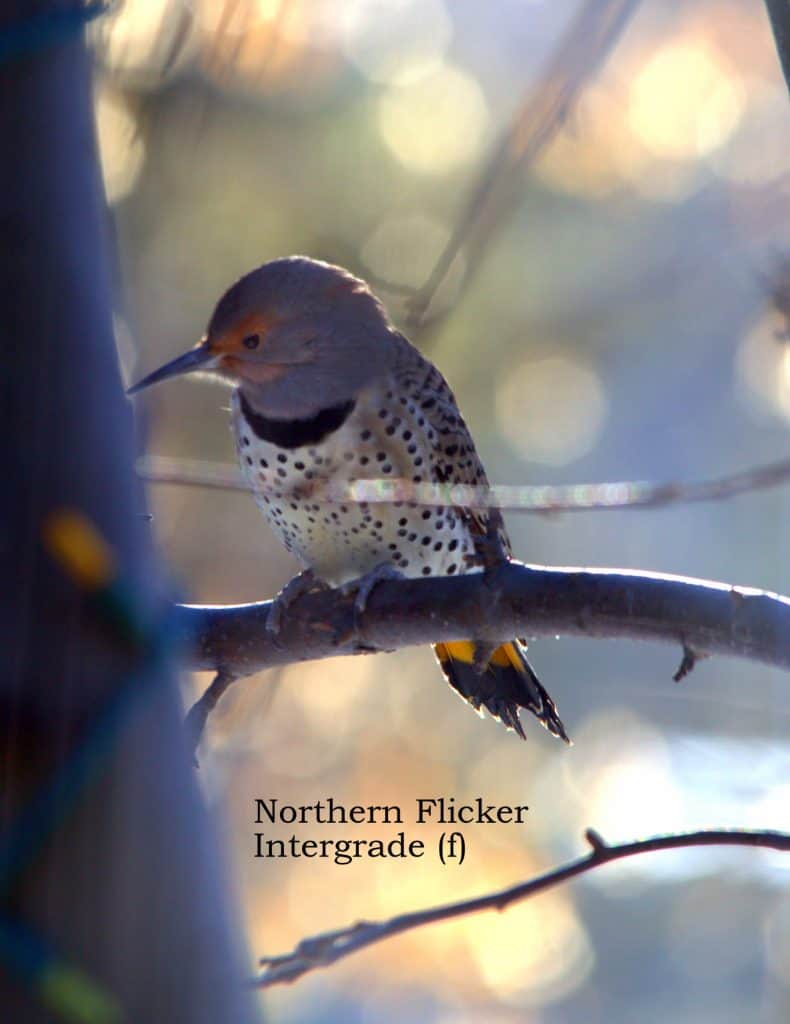
The intergrade northern flicker has a mix of the yellow-shafted and red-shafted birds’ colors.
Habitat
You’ll find northern flickers along the edges of forests and open wooded areas – including your backyard or the local park.
They avoid deep forests because remember – they are ground foragers.
Trees are still important for this bird because they are cavity nesters. More on that in a bit.
Diet & Feeding Behavior
The northern flickers’ #1 choice for food is ants. They’ll hop around the ground scooping up ants with their cleverly designed long & sticky tongue. Long and pointy beak allows them to dig into the earth rounding up more insects.
When their first food choice is in short supply they’ll turn to fruit, berries, seeds, and nuts.
They’re not above visiting backyard bird feeders either.
Sounds
Male flicker call
Mating, Nesting, Eggs, and Fledglings
Male flickers will drum to defend their territory along with various forms of aggression – wing flapping, calling, and swinging back and forth.
When it comes to courting, the couple performs a rather flamboyant dance. Check it out in this video.
These guys are cavity nesters so will look for a dead or dying tree to do what they do best – drill a hole to raise the family. Male and female will take turns excavating.
Alternatively, they will use a nesting box. They don’t add anything to the cavity – just their eggs.
Typically they have 1 brood each year with around 5-8 eggs. Southern birds may have up to 2 broods.
Incubation is done by both parents for 11-13 days and the young fledge at about 24-27 days – which is a relatively long time for wild birds.
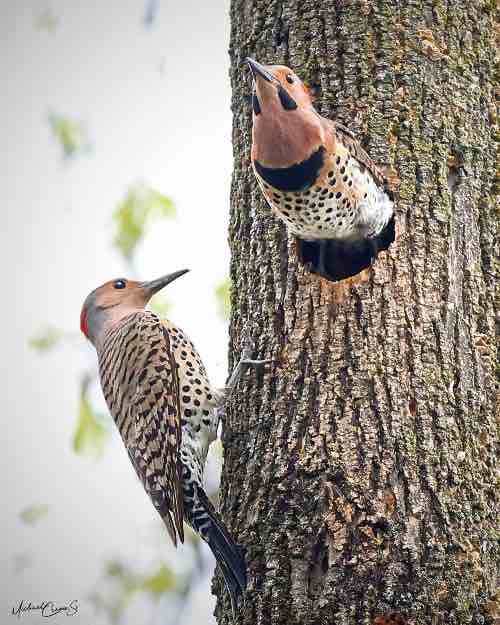
Predators
Their nests can fall prey to the typical raiding predators – raccoons, snakes, and squirrels.
Five Simple Ways Experts Attract Northern Flickers to Their Yard and You Can Too
1. Offer feeder food they like
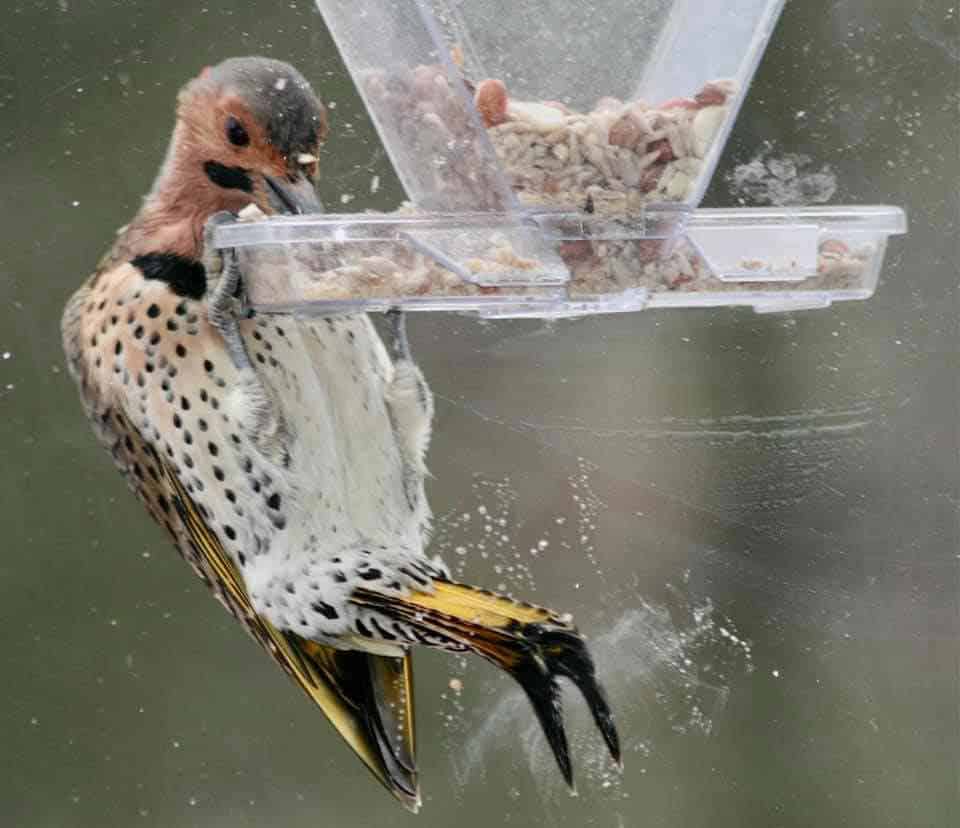
To attract northern flickers you should offer suet, peanut butter, peanuts, and safflower at the feeder. When insects are lacking (early spring and fall/winter) they are more apt to visit.
2. Avoid clearing dead, dying, or fallen trees
These birds are cavity nesters and real estate like this is at a premium in the wild. So, to further entice northern flickers leave your dead or dying trees – especially if it’s still standing. They make excellent cavity projects.
3. Plant fruit-bearing trees & shrubs
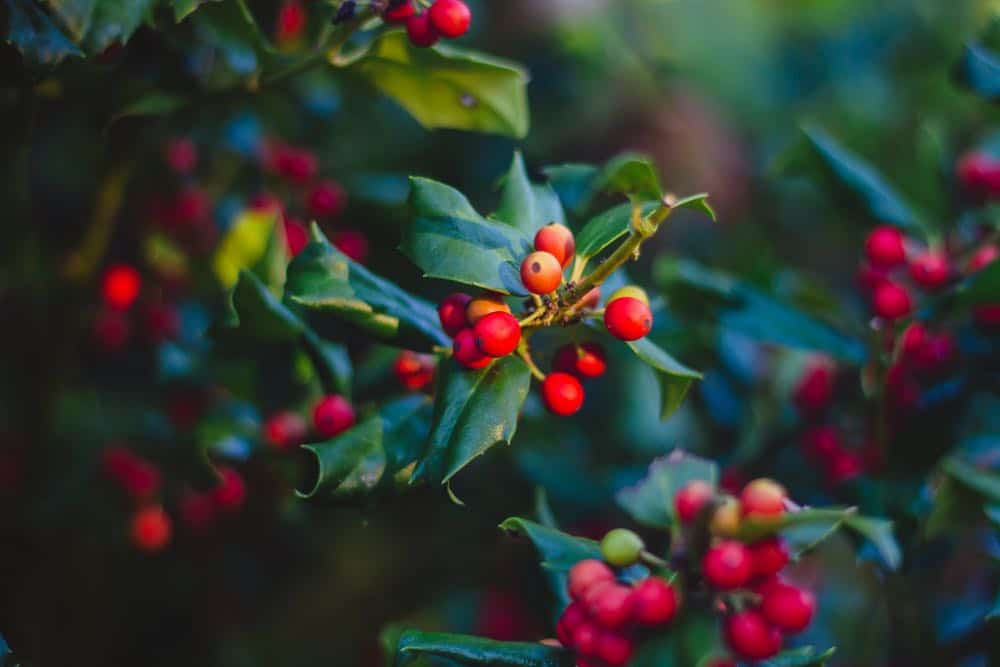
Although not something you can offer immediately, planting fruit trees and shrubs will attract northern flickers. And, they’ll effortlessly provide food year after year. Try planting some of these fruit-bearing plants:
- Greenbrier
- Hackberry
- Sassafras
- Blackberries
- Sumac
- Holly
- Dogwood
- Persimmon
- Elderberry
4. Have water available
Attract northern flickers with water. All birds need water to drink and bathe in and these guys are no different. If a natural source of water is not available nearby consider installing a pond – even a small patio pond will attract wild birds.
A birdbath is another viable option. Birds are drawn to moving water so adding a fountain to the birdbath could increase your chances of attracting one.
5. Hang a nesting box
You can entice northern flickers by installing a nesting box. It’s not their first choice but sometimes beggars can’t be choosers.
Making one available further increases your chances of attracting one to your area and helps the population achieve healthy status again. Just be sure to follow these guidelines:
- Hang the box in the interior of a wooded area, 6′-12′ above the ground.
- Mount to a pole at least 10′ away from the nearest tree and face south/southeast.
- The hole should be 2 1/2″ in diameter and the box should be 24″ deep, 7 1/4″ wide x 7 1/4″ high.
- Pack the box tight with sawdust or woodchips enabling some matter for the woodpecker to excavate.
- Attach guards to deter nest-raiding predators.
Nestwatch.org provides free nest box plans if you wish to build one yourself.
I think you’ll agree the northern flickers are worth the effort to attract to your yard. Take and apply some of the tips I provided or if you’re really serious about attracting them to your yard – apply all of them! Good luck and happy birding!
Frequently Asked Questions
Is the Northern Flicker protected?
Yes, the northern flicker is protected under the Migratory Bird Treaty Act which prohibits the killing, capturing, selling, trading, and transport of protected migratory bird species. Most native birds also have protection under this act.
Is the Northern Flicker rare?
No, the northern flicker is not rare. However, populations of this bird have been declining since 1960. This is likely due to the competition with non-native birds, such as European starlings, for nesting cavities along with the clearing of their natural habitat.
Do northern flickers return to the same nest every year?
Yes, northern flickers have been known to use the same nesting site the following year. They may use an existing site another woodpecker excavated the prior year as well.



